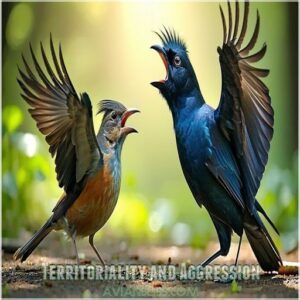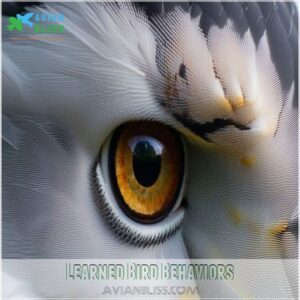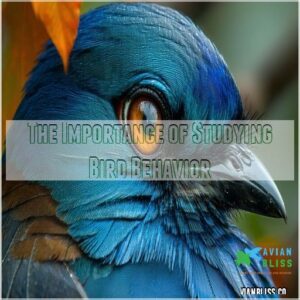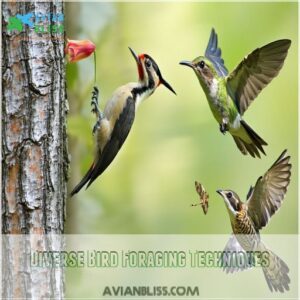This site is supported by our readers. We may earn a commission, at no cost to you, if you purchase through links.

During breeding season, they transform into stellar performers, showing off intricate dances and serenades to win mates.
In their social circles, birds share food, establish pecking orders, and even teach survival skills to younger members.
When danger strikes, they’ve got an arsenal of tricks: freezing in place, sounding alarms, or ganging up on larger predators. And that’s just their local behavior – wait until you learn about their incredible migration strategies. Their incredible migration strategies.
Table Of Contents
- Key Takeaways
- Unique Bird Behavioral Traits
- Types of Instinctive Bird Behaviors
- Learned Bird Behaviors
- The Importance of Studying Bird Behavior
- Amazing Bird Migration Patterns
- Diverse Bird Foraging Techniques
- Bird Social Dynamics and Interactions
- Human Impact on Bird Behavior
- Unusual Bird Behaviors Explained
- Frequently Asked Questions (FAQs)
- What are the unusual behavior of birds?
- What are the unique abilities of birds?
- What are some behavioral characteristics of the bird?
- How do you read bird behavior?
- Why do birds suddenly abandon their nests?
- How do birds choose their specific mates?
- Can birds recognize individual human faces?
- How do urban birds adapt their songs?
- Do birds play and show emotions like mammals?
- Conclusion
Key Takeaways
- You’ll be amazed at birds’ ability to outsmart predators and find food, using tools like crows wielding twigs and herons engaging in cooperative hunting.
- During breeding season, birds put on stunning courtship displays involving intricate dances and songs to attract mates.
- Birds form complex social networks, sharing resources and teaching survival skills through cooperative behaviors and communication signals.
- Their migratory skills are jaw-dropping, navigating vast distances with the help of Earth’s magnetic field, celestial cues, and landmarks for precise travel.
Unique Bird Behavioral Traits
You’ll be amazed by the incredible ways birds outsmart predators, find food, and even use tools to solve problems in their daily lives.
From clever foraging strategies to elaborate courtship dances, you’re about to discover how these feathered friends use their natural instincts and learned behaviors to thrive in our ever-changing world.
Foraging Strategies
Ever wonder how birds find their next meal?
Their diets change seasonally, reflecting food availability, as seen in seasonal bird diets.
From crafty crows using twigs as tools to catch insects, to cooperative hunting among herons, birds showcase remarkable foraging strategies.
You’ll spot them employing diverse techniques: pecking seeds from the ground, swooping through the air to catch bugs, or drilling into tree bark with specialized bills.
Their sharp eyesight and lightning-quick movements make them incredibly efficient hunters.
Mating and Breeding Behaviors
Strutting their stuff during breeding season, birds put on some of nature’s most spectacular courtship displays.
Regarding finding the perfect mate, these feathered performers go all out with: elaborate dance moves, from moonwalks to sky-high acrobatics, as seen in various Bird Mating Dance displays.
Elaborate dance moves, from moonwalks to sky-high acrobatics, 2. Mesmerizing vocal serenades that can last for hours, 3. Flashy fashion shows featuring puffed feathers and spread wings.
Once paired up, they’ll carefully build nests and share parenting duties, proving they’re not just show-offs but dedicated partners.
Social Structures and Interactions
While some birds prefer a solitary lifestyle, most thrive in complex social networks.
You’ll find fascinating flocking dynamics where birds work together, sharing food discoveries and establishing clear pecking orders.
Through intricate communication signals, they maintain social bonds and teach survival skills to their young.
From cooperative breeding in Florida Scrub-Jays to the tight-knit colonies of penguins, their social structures showcase remarkable intelligence and adaptability.
Predator Evasion Techniques
Birds have mastered the art of staying alive through clever tricks.
Their alarm calls work like a neighborhood watch system – one bird spots trouble and everyone knows about it.
You’ll notice how they freeze like statues when danger’s near, making them nearly invisible to predators.
Through mobbing tactics, smaller birds gang up on larger predators, proving there’s strength in numbers against hawks and owls.
Migration Patterns
When you witness the spectacle of seasonal bird migration, you’re watching an intricate dance of survival that’s guided by genetic programming and environmental cues.
These incredible journeys follow both traditional routes and flexible patterns, adapting to changing conditions.
You’ll notice birds traveling in distinctive V-formations, using landmarks, celestial cues, and Earth’s magnetic field to navigate across continents and oceans.
Types of Instinctive Bird Behaviors
You’ll be amazed by the built-in behaviors that birds are born knowing, from their intricate courtship dances to their precise nest-building techniques.
Whether you’re watching a cardinal defend its territory or a flock of geese flying in perfect V-formation, you’re seeing these remarkable instincts in action.
Territoriality and Aggression
Have you ever seen two songbirds squaring off like tiny warriors?
In the avian world, territory means everything.
You’ll spot them fiercely defending their space through aggressive displays and boundary disputes. They’ll puff up their feathers, spread their wings, and even engage in physical confrontations to guard their resources.
It’s not just about space – they’re protecting feeding grounds, nesting sites, and their families.
Courtship Displays and Songs
While territorial displays show aggression, courtship reveals nature’s most spectacular performances.
You’ll witness intricate bird behavior mating rituals where males pull out all the stops – from elaborate dance moves to show-stopping plumage displays.
Male birds become natural performers, using their vibrant feathers and melodic songs to woo potential mates.
These displays aren’t just for show; they demonstrate genetic fitness and readiness for successful breeding partnerships.
Flock Behavior and Communication
Beyond their beautiful courtship displays, birds are masters of group living.
You’ll notice flocks moving like synchronized dancers, with each member responding instantly to subtle signals.
Through a mix of calls, body language, and visual cues, they share important information about food sources and threats.
Ever seen a flock split and reform mid-flight? That’s their remarkable communication system at work, keeping everyone safe and fed. group living. remarkable communication system. food sources and threats.
Nest Building and Parental Care
Inside their carefully chosen nesting spots, birds showcase remarkable parenting skills.
You’ll spot them weaving intricate nests from twigs, grass, and even spider silk, creating perfect nurseries for their eggs. These complex structures require specific materials, and some birds even utilize human-made products found at stores that sell bird nest kits.
During incubation, parents take turns keeping eggs warm and defending territory.
Once chicks hatch, it’s a non-stop delivery service of insects and seeds, with both parents working tirelessly until their young are ready to fly.
Learned Bird Behaviors
You’ll be amazed to discover that birds aren’t just following their instincts – they’re actually learning new tricks and passing them down to future generations, just like we do.
From figuring out how to use tools to adapting to city life, these feathered friends are showing us they’re way smarter than we once thought.
Tool Use and Cooperative Hunting
Moving beyond instinct, some birds are true innovators.
You might spot clever crows using sticks as tools to snag tasty insects, or watch them drop nuts onto crosswalks – letting passing cars crack them open!
Many bird enthusiasts even purchase products like bird-friendly feeders and DIY bird tool kits from online stores like bird tool use supplies.
Even more fascinating is how birds team up to hunt: Harris’s hawks form hunting parties of 2-6 birds, coordinating their attacks to catch prey that’d be impossible to catch solo.
Adaptation to Human Environments
Urban birds are nature’s master adapters, constantly evolving their behaviors to thrive in our concrete jungles. You’ll spot pigeons nesting on skyscrapers, crows using traffic patterns for walnut cracking, and sparrows learning to trigger automatic doors for shelter. These adaptations showcase their remarkable intelligence and resilience in human-dominated landscapes.
- Ravens in Tokyo have learned to use wire hangers as nest-building materials
- European starlings mimic car alarms and phone ringtones in their songs
- House finches now prefer artificial lighting for extended foraging hours
- Pigeons in Barcelona ride the subway between feeding locations
- Urban mockingbirds recognize and remember human faces who’ve threatened their nests
Response to Climate Change
Birds are adapting faster than you’d think to our changing climate. Let’s check out some fascinating ways our feathered friends are rolling with the punches:
| Adaptation | Impact | Solution |
|---|---|---|
| Earlier breeding | Mismatched food timing | Flexible nesting schedules |
| Range shifts | Loss of habitat | Moving to cooler areas |
| Migration changes | Disrupted food chains | New stopover sites |
| Body size changes | Heat stress | Smaller bodies for better cooling |
You’ll spot Great Tits now nesting two weeks earlier than in the 1970s, while European Blackbirds are skipping migration altogether.
Cultural Transmission of Behaviors
Just like humans pass down family traditions, you’ll find fascinating examples of learned behaviors in bird communities.
Young birds pick up specific song dialects from their parents, creating distinct "accents" in different regions, which is an essential part of bird behavior communication methods.
They’ll even learn specialized foraging techniques from their flock mates.
Take New Caledonian crows – they’re masters at passing down tool-making skills through generations, crafting hooks from twigs to catch tasty treats.
The Importance of Studying Bird Behavior
You’ll be amazed at how studying bird behavior can reveal nature’s secrets, from their incredible navigation abilities to their complex social lives.
When you watch birds closely, you’re not just observing their daily routines – you’re uncovering clues about evolution, climate change, and the health of our environment.
Conservation Implications
Understanding how birds adapt to environmental pressures isn’t just essential for their survival – it’s our window into effective conservation strategies.
When you study their behaviors, you’ll uncover key clues about habitat requirements, breeding success rates, and population dynamics.
This knowledge helps conservationists develop targeted protection measures, from creating safer migration corridors to implementing climate-smart habitat management techniques. Conservation strategies are thus informed by bird adaptations.
Insights Into Evolutionary History
Through the fascinating lens of bird behavior, you’ll discover incredible insights into our planet’s evolutionary past.
When you observe how different species adapt and evolve, you’re witnessing evolution in action.
From the remarkable adaptive radiation of Darwin’s finches to the convergent evolution seen in hummingbirds worldwide, these patterns reveal nature’s innovative solutions.
Sexual selection and coevolution continue shaping avian traits today, writing new chapters in life’s story.
Understanding Ecological Roles
Birds serve as nature’s multitasking specialists, each filling unique ecological niches that keep our ecosystems humming.
You’ll find these feathered architects shaping their environment through seed dispersal, pollination, and pest control.
They’re like nature’s quality control team – from hummingbirds pollinating flowers to woodpeckers controlling insect populations. Ecosystem engineering at its finest.
Ever notice how birds maintain the delicate balance between predator and prey? That’s ecosystem engineering at its finest.
Informing Wildlife Management
By studying bird behaviors, wildlife managers gain important insights that shape conservation strategies. You’ll see how these observations directly influence habitat preservation and help reduce human-wildlife conflicts.
- Population monitoring reveals migration pattern changes due to climate shifts
- Nesting habits guide protected area designations
- Predator avoidance behaviors inform corridor planning
- Feeding patterns help assess ecosystem health
- Social dynamics influence breeding program success
Amazing Bird Migration Patterns
You’ll be amazed to discover how birds navigate their epic journeys across continents using everything from landmarks to the stars.
Whether they’re soaring thousands of feet up mountains or crossing entire oceans, these feathered travelers have mastered the art of finding their way.
In ways that’ll make your smartphone’s GPS look simple.
Long-Distance Migrations
You’ll be amazed to discover how these feathered marathoners tackle epic journeys spanning continents.
Arctic Terns hold the record, flying over 44,000 miles annually between the Arctic and Antarctic.
They’ve mastered incredible navigation skills, using Earth’s magnetic field, celestial cues, and landmarks. During these long-distance migrations, birds make strategic stopovers to rest and refuel, often returning to the exact same locations year after year. These amazing birds truly are remarkable navigators.
Altitudinal Migrations
A fascinating dance unfolds in mountainous regions where birds perform vertical migrations instead of crossing continents. Like nature’s elevator, these altitudinal migrations help birds adapt to seasonal changes.
Here’s what drives these remarkable journeys:
- Temperature shifts force birds to seek warmer elevations
- Snow cover impacts access to essential food sources
- Breeding grounds availability varies with altitude
- Changes in vegetation patterns affect shelter options
Irruptive Migrations
During harsh winters, some birds exhibit dramatic irruptive migrations when food becomes scarce in their usual territory.
Here’s what triggers these unexpected movements:
| Trigger | Impact | Example Species |
|---|---|---|
| Seed Crops | Poor pine cone yield | Pine Siskins |
| Rodent Cycles | Low lemming numbers | Snowy Owls |
| Berry Production | Failed fruit crops | Bohemian Waxwings |
These unpredictable movements can bring rare northern visitors to your backyard, making every winter bird watch an adventure.
Navigation and Orientation
Birds navigate with built-in tools that’d make any GPS jealous.
Like tiny compasses, they sense Earth’s magnetic field and use the sun and stars as guides.
Some species, like the Arctic Tern, memorize landmarks during their epic journeys.
They’re natural masters at processing multiple sensory inputs – from visual cues to magnetic signals – making their navigation skills nothing short of extraordinary.
Diverse Bird Foraging Techniques
You’ll be amazed by the clever ways birds find their next meal, from woodpeckers drilling into tree bark to hummingbirds sipping nectar mid-flight.
Whether you’re watching finches crack seeds or hawks swooping for fish, you’re witnessing some of nature’s most innovative eating techniques.
These eating techniques have evolved over millions of years.
Seed-Eating and Granivory
Seed-eating champions like finches and sparrows don’t just randomly peck at seeds – they’ve got specialized bills that work like built-in nutcrackers.
Finches, in particular, require a quality best bird food for finches that includes a mix of seeds, such as millet and nyjer seed, to thrive.
Take the Red Crossbill, whose crossed bill tips act as precision tools for prying open pine cones.
These tiny engineers can even sort seeds by size and weight, storing the best ones for later.
It’s like having a natural Swiss Army knife attached to their face!
Insectivory and Aerial Foraging
While granivores specialize in seeds, aerial hunters take insect-catching to spectacular heights.
You’ll witness these masters of flight snatch bugs mid-air, performing acrobatic twists and turns at breakneck speeds.
Swift reactions and keen eyesight let them track tiny prey, while specialized beaks help them snag insects efficiently.
It’s like watching nature’s fighter pilots in action, executing perfect intercepts with military precision.
Nectarivory and Pollination
Three remarkable adaptations help nectar-feeding birds excel at pollination.
Their specialized bills and brush-tipped tongues are perfectly suited for reaching deep into flowers.
Ultraviolet-sensitive vision helps them spot nectar guides – invisible patterns that lead straight to sweet rewards.
This fascinating partnership between birds and flowers has evolved over millions of years, benefiting both species through efficient pollination.
Piscivory and Aquatic Foraging
When you watch fish-eating birds in action, you’re witnessing nature’s master anglers at work. These specialized hunters have developed incredible techniques to catch their underwater prey.
- Ospreys plunge from heights of 100+ feet, hitting the water at 40 mph
- Kingfishers hover perfectly still before diving like arrows
- Herons stand motionless for minutes, striking with lightning speed
- Cormorants chase fish underwater using their powerful webbed feet
- Grebes perform synchronized dances before diving together
Bird Social Dynamics and Interactions
You’ll be amazed to discover how birds form complex social networks.
From lifelong pair bonds to cooperative breeding groups that work together like tiny feathered families.
Just like you’ve got your own social circle, birds create intricate hierarchies and alliances.
Using everything from gentle songs to dramatic displays to maintain their relationships.
Pair Bonding and Mating
Just like avian foraging habits, birds have fascinating love lives that’ll make you rethink romance.
Birds form intense relationships through elaborate courtship rituals – from synchronized dances to gift-giving displays.
You’d be amazed to watch male birds show off their best moves, singing complex songs and flashing brilliant feathers. Some species, like swans, even mate for life, establishing powerful pair bonds that last years. mating for life.
Cooperative Breeding and Sociality
Birds showcase remarkable social bonds through cooperative breeding, where family members help raise chicks that aren’t their own.
You’ll find helper birds bringing food, defending nests, and even babysitting younger siblings.
This altruistic behavior stems from kin selection, where relatives work together to guarantee their shared genes survive. Florida Scrub-Jays and Australian Fairy-wrens are perfect examples of these fascinating family dynamics.
Dominance Hierarchies and Agonistic Behavior
At the center of every bird flock, you’ll find a complex social ladder that rivals high school politics.
Dominant birds get first dibs on food, mates, and prime perching spots through a mix of chest-puffing displays, aggressive pecking, and threat displays.
The pecking order isn’t set in stone – younger birds can challenge seniors, and hierarchies shift with seasonal changes or when resources become scarce.
Human Impact on Bird Behavior
You’ll be amazed at how your everyday actions, from filling backyard bird feeders to turning on porch lights, can reshape the behavior of our feathered friends.
Whether you’re living in a bustling city or a quiet suburb, you’re constantly influencing how birds adapt, feed, and survive in our shared environment. reshaping the behavior of birds and influencing how birds adapt.
Urbanization and Habitat Destruction
Rapid urbanization has transformed countless bird habitats into concrete jungles, yet many species show remarkable adaptability.
Here’s what you’ll discover about urban bird behavior:
- Some species thrive by nesting in building cavities and feeding on human refuse
- City-dwelling birds sing at higher frequencies to overcome traffic noise
- Urban birds display bolder personalities and shorter flight distances from humans
These adaptations showcase their incredible resilience in human-modified landscapes.
Climate Change and Phenological Shifts
Global temperatures have dramatically shifted how birds adapt and survive. You’ll notice changes in their migration patterns and breeding schedules – nature’s clock is running fast forward.
Here’s what scientists have observed:
| Phenological Change | Impact on Birds |
|---|---|
| Earlier Springs | Advanced breeding times |
| Warmer Winters | Delayed migration south |
| Temperature Extremes | Changed feeding patterns |
| Extended Summers | Altered mating seasons |
| Shifting Rainfall | Modified nesting cycles |
These behavioral shifts signal how climate change reshapes our feathered friends’ daily routines.
Bird Feeding and Supplemental Food
Putting out bird feeders has dramatically changed how our feathered friends interact with urban environments.
You’ll notice birds adapting their foraging techniques and nesting habits around reliable food sources.
Some species have even altered their migration patterns, staying year-round where they once departed seasonally.
While supplemental feeding can help birds through tough winters, it’s essential to choose appropriate feeder types and food choices.
Conservation Efforts and Education
Conservation warriors like you make a huge difference in bird protection.
Through citizen science projects, you’re helping track behaviors and populations.
Habitat restoration efforts give birds back their homes.
Education programs and ethical birding guidelines teach future generations to respect our feathered friends.
Your involvement in policy advocacy guarantees birds have a voice when decisions affect their survival.
Unusual Bird Behaviors Explained
You’ll discover how birds break their usual routines with surprising behaviors, from using tools to catch prey to performing elaborate courtship dances that seem straight out of a talent show.
If you’ve ever wondered why some birds act in unexpected ways, you’re about to learn the fascinating science behind their most unusual habits.
from rare migration patterns to unique social bonds that challenge what people understand about avian intelligence.
Abnormal Mating Behaviors
Understanding abnormal mating behaviors in birds reveals fascinating insights into avian social dynamics.
You’ll discover peculiarities that challenge our understanding of bird courtship rituals.
Here are three intriguing examples:
- Same-sex penguin pairs often successfully raise adopted chicks
- Some ducks exhibit forced copulation during breeding season
- Different species sometimes form hybrid pairs, like mallards and black ducks
These behaviors remind us that nature isn’t always predictable.
Unusual Foraging Strategies
Birds aren’t just masters of conventional hunting – they’re clever innovators in finding food.
You’ll be amazed to see corvids crafting hooks from twigs to catch insects, or watch seabirds dropping shellfish onto rocks to crack them open.
Some species even team up, with one bird flushing out prey while others wait to snatch it mid-air. These crafty strategies showcase nature’s ingenuity. Clever innovators find food in amazing ways. Corvids crafting hooks and seabirds dropping shellfish are examples of this.
Rare Migration Patterns
Not all feathered wanderers follow the beaten path.
While studying uncommon routes, you’ll discover fascinating migration mysteries that challenge our understanding of bird navigation skills.
Here are three mind-bending patterns:
- Some warblers take mid-migration "vacations," stopping at unexpected locations for weeks
- Arctic Terns navigate figure-eight patterns across oceans
- Certain hummingbirds travel solo instead of in flocks
These timing shifts and route variations show nature’s endless capacity to surprise us.
Unique Social Interactions
Beyond their predictable flight paths, you’ll discover that birds have complex social lives filled with unexpected behaviors.
Some species engage in cooperative breeding, where younger birds help raise their siblings instead of starting their own families.
Here’s a fascinating look at unique bird interactions:
| Behavior | Description | Example Species |
|---|---|---|
| Mobbing | Group defense | American Crows |
| Allopreening | Social grooming | Monk Parakeets |
| Food sharing | Resource division | Florida Scrub-Jays |
| Teaching | Skill transfer | Green-backed Tits |
| Grieving | Death response | Western Scrub Jays |
Frequently Asked Questions (FAQs)
What are the unusual behavior of birds?
Ever seen a bird pretending to be dead? It’s a strategy called "playing possum" that distracts predators.
Some birds even mimic other species’ calls or use tools to find food.
Makes you look at them differently, doesn’t it?
What are the unique abilities of birds?
Birds have unique abilities like keen navigation using Earth’s magnetic fields.
Their impressive mimicry skills with both sounds and appearances are also noteworthy.
Remarkable flight adaptations and vibrant courtship dances are further examples of their capabilities.
Some birds even use tools, thanks to sharp intellects.
What are some behavioral characteristics of the bird?
Bird behaviors captivate through diverse feeding techniques, intricate courtship rituals, and strategic predator evasion.
They sing to claim territory, build nests thoughtfully.
Migrate skillfully—fancy flight paths guided by stars, blending instinct with environmental cues.
How do you read bird behavior?
Picture yourself as a detective, piecing together a mystery.
To read bird behavior, observe their movements and sounds, noting feeding, flocking, or alarm calls.
Use binoculars and field guides to deepen your understanding and enjoyment.
Why do birds suddenly abandon their nests?
Ever wonder why a bird’s nest is suddenly empty?
Predators, human disturbance, or insufficient food could’ve scared them off.
Sometimes, it’s simply time to move on to a new nesting spot.
How do birds choose their specific mates?
Birds choose mates through elaborate displays like dances and songs, signaling fitness and compatibility.
They assess qualities such as plumage, vocal ability, and behavior.
These assessments help them decide if a partner is suitable for raising offspring.
Can birds recognize individual human faces?
Yes, birds can recognize human faces.
Studies suggest that species like crows and magpies remember individual faces, associating them with helpful or threatening interactions.
It’s like having a photographic memory—pretty impressive for our feathered friends!
How do urban birds adapt their songs?
In bustling cities, birds tweak their tunes to cut through the noise.
Often singing louder and at higher pitches.
This urban remix helps them chat over traffic, showing their knack for adapting to city life’s challenges.
Do birds play and show emotions like mammals?
Imagine birds tossing leaves like kids in autumn.
They exhibit playful behaviors, showing curiosity and social bonds.
Their antics—like sliding on snow—display joy, hinting at emotions, much like your furry friends at home.
Conclusion
Isn’t it fascinating how much we can learn from birds? From their tool-using antics to their epic migrations, these amazing bird behaviors explained how adaptable and intelligent our feathered friends truly are.
Whether they’re traversing vast distances or crafting intricate nests, birds never cease to surprise us with their ingenuity.
As you step outside and observe the avian world, you’ll find countless lessons on survival, cooperation, and resilience. So, what’ll birds teach you today?

















